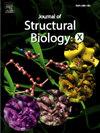追踪支架蛋白DISC1的聚集途径:慢性精神疾病的结构意义
IF 5.1
Q2 BIOCHEMISTRY & MOLECULAR BIOLOGY
引用次数: 0
摘要
精神分裂症1号蛋白(DISC1)是一种多角性支架蛋白,被认为包括大的无序区域和四个不同的结构片段,其中螺旋或螺旋折叠的比例很高。DISC1与超过300种蛋白质相关,并与从有丝分裂到细胞分化的多种生理作用相关。然而,这种蛋白质的结构特征却没有得到很好的表征。c端区域(C-region,文献691-836)形成一个四聚体,也可以聚集成淀粉样纤维,可能与精神分裂症和其他慢性精神疾病有关。采用生物物理和结构生物学相结合的方法,研究了c区三种移码突变体,即S713E、S704C和l807的结构异质性。我们为C区的可塑性提供了证据;一个薄薄的边界将DISC1的构象灵活性与无数伙伴的相互作用与破坏性聚集分开。呈现了从细胞核生长的聚集体和原纤维的快照,以及支持c区最小成纤维元素(β核)作用的数据。该片段还包含一段对有丝分裂纺锤体复合体中NDEL1蛋白结合至关重要的残基,并且在非结合剪接变体DISC1Δ22aa中不存在。从生理学上讲,剪接变体和纤维都代表了破坏细胞分裂的功能丧失状态。我们的研究结果强调需要破译DISC1 c区域的结构元素,以了解其生理作用和聚集相关的异常,并为药物开发建立理论基础。本文章由计算机程序翻译,如有差异,请以英文原文为准。
Tracing the aggregation pathway of the scaffold protein DISC1: Structural implications for chronic mental illnesses
Disrupted in schizophrenia 1 (DISC1) is a pleiotropic scaffold protein that is postulated to comprise large disordered regions and four distinct structured segments with a high proportion of helical or coiled-coil fold. DISC1 associates with over 300 proteins and is associated with several physiological roles ranging from mitosis to cellular differentiation. Yet, the structural features of the protein are poorly characterized. The C-terminal region (C-region, res. 691–836) forms a tetramer and can also aggregate into amyloid-like fibers, potentially linked to schizophrenia and other chronic mental illnesses. Using a combination of biophysical and structural biology applications, we investigate the structural heterogeneity of three mutants of the C-region, viz., the S713E, S704C and L807-frameshift mutants. We provide evidence for the plasticity of the C region; a thin border separates the conformational flexibility of DISC1 required for interaction with a myriad of partners from disruptive aggregation. Snapshots of aggregates and fibrils growing from a nucleus are presented, along with data supporting the role of the minimal fibrillizing element in the C-region, the β-core. This segment also houses a stretch of residues that is critical for the binding of NDEL1 proteins in the mitotic spindle complex and is absent in the non-binding splice variant DISC1Δ22aa. Physiologically, both the splice variant and the fibers represent loss-of-function states that disrupt cellular division. Our findings highlight the need to decipher the structural elements within the DISC1 C-region to comprehend its physiological role and aggregation-related anomalies, and to establish a rationale for drug development.
求助全文
通过发布文献求助,成功后即可免费获取论文全文。
去求助
来源期刊

Journal of Structural Biology: X
Biochemistry, Genetics and Molecular Biology-Structural Biology
CiteScore
6.50
自引率
0.00%
发文量
20
审稿时长
62 days
 求助内容:
求助内容: 应助结果提醒方式:
应助结果提醒方式:


